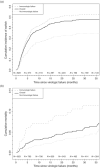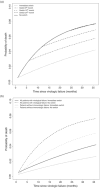Delayed switch of antiretroviral therapy after virologic failure associated with elevated mortality among HIV-infected adults in Africa
- PMID: 24977440
- PMCID: PMC4317283
- DOI: 10.1097/QAD.0000000000000349
Delayed switch of antiretroviral therapy after virologic failure associated with elevated mortality among HIV-infected adults in Africa
Abstract
Objective: Routine monitoring of plasma HIV RNA among HIV-infected patients on antiretroviral therapy (ART) is unavailable in many resource-limited settings. Alternative monitoring approaches correlate poorly with virologic failure and can substantially delay switch to second-line therapy. We evaluated the impact of delayed switch on mortality among patients with virologic failure in Africa.
Design: A cohort.
Methods: We examined patients with confirmed virologic failure on first-line nonnucleoside reverse transcriptase inhibitor (NNRTI)-based regimens from four cohorts with serial HIV RNA monitoring in Uganda and South Africa. Marginal structural models aimed to estimate the effect of delayed switch on mortality in a hypothetical trial in which switch time was randomly assigned. Inverse probability weights adjusted for measured confounders including time-updated CD4+ T-cell count and HIV RNA. Results: Among 823 patients with confirmed virologic failure, the cumulative incidence of switch 180 days after failure was 30% [95% confidence interval (CI) 27-33]. The majority of patients (74%) had not failed immunologically as defined by WHO criteria by the time of virologic failure. Adjusted mortality was higher for individuals who remained on first-line therapy than for those who had switched [odds ratio (OR) 2.1, 95% CI 1.1-4.2]. Among those without immunologic failure, the relative harm of failure to switch was similar (OR 2.4; 95% CI 0.99-5.8) to that of the entire cohort, although of borderline statistical significance.
Conclusion: Among HIV-infected patients with confirmed virologic failure on first-line ART, remaining on first-line therapy led to an increase in mortality relative to switching. Our results suggest that detection and response to confirmed virologic failure could decrease mortality.
Conflict of interest statement
Figures


References
-
- Panel on Antiretroviral Guidelines for Adults and Adolescents. Guidelines for the use of antiretroviral agents in HIV-1-infected adults and adolescents. [Accessed 5 November 2013];Department of Health and Human Services. http://aidsinfo.nih.gov/ContentFiles/Adultand.AdolescentGL.pdf.
-
- Stringer JS, Zulu I, Levy J, Stringer EM, Mwango A, Chi BH, et al. Rapid scale-up of antiretroviral therapy at primary care sites in Zambia: feasibility and early outcomes. JAMA. 2006;296:782–793. - PubMed
Publication types
MeSH terms
Substances
Grants and funding
LinkOut - more resources
Full Text Sources
Other Literature Sources
Medical
Research Materials

